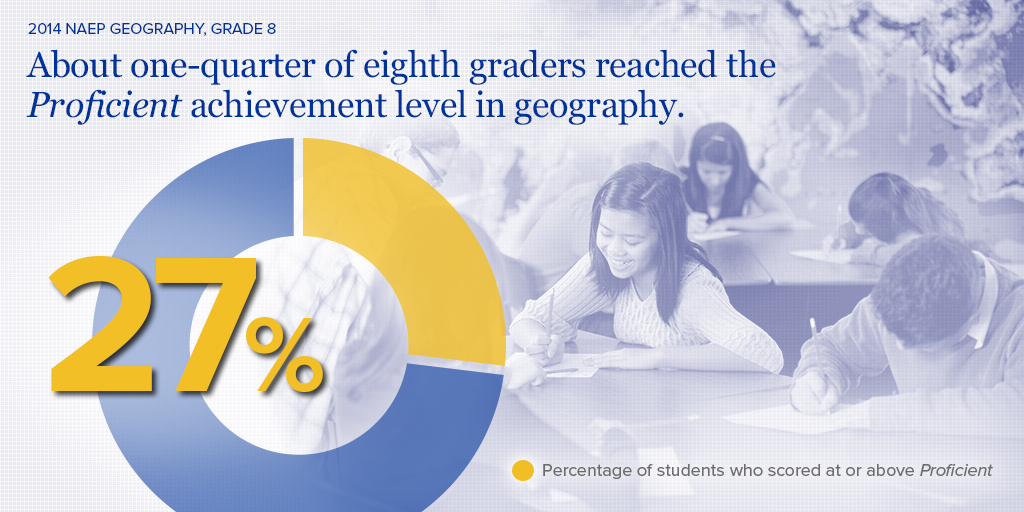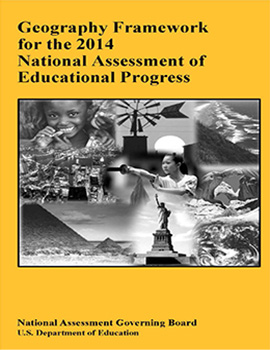
2014 Civics, Geography and U.S. History Report Card
No change in eighth-graders’ performance in U.S. history, geography, civics since 2010
But Hispanic students’ scores up in U.S. history, geography from 2010; overall increases seen since 1990s
WASHINGTON, April 29, 2015 — The overall academic performance of eighth-graders in U.S. history, geography and civics has remained unchanged since 2010, according to The Nation’s Report Card: 2014 U.S. History, Geography, and Civics, though Hispanic students have made gains in U.S. history and geography. Compared with the first U.S. history assessment in 1994 and first civics assessment in 1998, overall average scores are higher — but in 2014, 3 percent or less scored at the Advanced level in any of the three subjects. Geography is the only subject of the three in which there has not been a change in overall scores since its first assessment in 1994.

The Governing Board plans to have the U.S. history, geography and civics assessments administered to eighth- and 12th-grade students next in 2018. For the first time, these three assessments will be entirely computer-based — a model by which all NAEP assessments will be administered. Highlights from each subject are below:
U.S. history – This assessment asked questions in four themes: democracy, culture, technology and world role. For example, a democracy-themed question asks students to identify the effect of a Supreme Court case:
The Supreme Court’s 1803 decision in Marbury v. Madison established the court’s power to:
A. Impeach a president
B. Decide whether a federal law is constitutional
C. Resolve conflicts between states
D. Resolve conflicts between the president and Congress
The correct answer is B, which 41 percent of students selected.
- Both male and female Hispanic students have made gains since 2010. The average score for female Hispanic students is up 4 points; male Hispanic students scored 5 points higher.
- Scores are higher in all themes except technology since 1994. In the context of the U.S. history assessment, technology focuses on the transformation of the American economy from rural frontier to industrial superpower and its impact on society, ideas and the environment.
- A score gap between male and female students did not exist in 1994; however, it did exist in 2014, with male students scoring 4 points higher than female students.
There has been no statistically significant change in the gender gap since the assessment began in 1994.
The way students absorb information is changing. We need to meet them where they are to improve learning. Chasidy White, @GovBoard member
Geography – Questions on this assessment measured students’ knowledge in space and place; environment and society; and spatial dynamics and connections. For example, an environment and society-themed question asked students to use a map to explain the impact of ocean currents on a continent:
The Brazil and the Peru currents affect the climate of South America. Explain what effect each of these
currents has on the temperature and rainfall of their adjacent land areas.
Seven percent of students received the highest-score rating of “Complete.”
- Since 1994, lower-performing students have made gains, resulting in 4 percent fewer students below the Basiccategory and 5 percent more at the Basic level.
- Since 1994, score gains for black and Hispanic students (11 and 10 points, respectively) have been larger than those for white students (4 points).
- Since 2010, Hispanic students have made a 4-point gain; however, their achievement gap with white students did not change significantly.
Sen. Alexander Reflects on NAEP Geography Results
Key federal education policymaker comments on the 2014 results of NAEP geography, civics, and U.S. history assessments.
Civics – Students were asked about civic life, politics and government; the foundations of the American political system; government embodiment of American democracy; the relationship of the U.S. with other nations; and the roles of citizens. For example, a short-answer civics question about world affairs asked students to explain the benefits of international interactions as they relate to trade, treaties and agreements, and humanitarian aid. In 2014, 62 percent of eighth-graders’ responses were rated as “Complete.”
- Hispanic students’ scores have increased since 1998, narrowing the achievement gap with white students by 8 points.
- Although there have been gains among lower-performing students since 1998, with a higher percentage of students scoring at Basic and a lower portion below Basic, there has been no change in the percentage of students overall scoring at or above the Proficient level since 1998.
- The scores of black male students have increased by 6 points since 1998.
- Civics is the only subject without a significant gender gap: The 4-point gap between male and female students in 1998 has closed.
The full set of data is available through the interactive reports, in which, for example, users can view scores in all subjects by racial/ethnic group in the context of other variables such as parental education, school location or gender; or, as another example, compare the performance of Hispanic students whose parents graduated from high school to Hispanic students whose parents graduated from college. For more information, visit www.nagb.org/2014-history-geo-civics.


